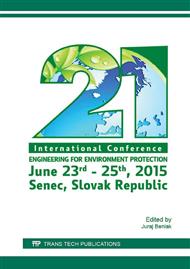p.10
p.18
p.23
p.31
p.39
p.49
p.55
p.63
p.69
Recovery of Copper and Tin from Used Printed Circuit Boards
Abstract:
This work focuses on possibilities to recover tin and copper by hydrometallurgical processes from printed circuit boards (PCBs) of discarded personal computers after thermal treatment. For experimental work crushed and sorted printed circuit boards with various granularity /-8 +0 mm, -8 +3 mm, -3 +0 mm/ were used. They were exposed to thermal treatment at temperatures 300 °C, 500 °C, 700 °C and 900 °C before leaching for 15, 30 and 60 minutes. The two thermal treatments were studied: in air flow, i.e. burning, and pyrolysis (without air flow). For leaching experiments 1M solution of HCl at 80 °C was used. Under the mentioned conditions both samples, the thermally treated sample of PCB as well as the original untreated printed circuit board, were leached with the aim to compare the experimental results. Weight losses during burning accounted for 5 to 35 %, while pyrolysis caused weight losses from 10 to 30 %, depending on the thermal treatment temperature. The higher the burning temperature, the higher the extraction of copper into the solution with up to 98%.However, extraction of copper from non-burned samples does not exceeded 6 %. An opposite effect has been observed during leaching of tin, where the highest extraction was reached using thermally untreated samples, and extraction decreased with an increasing burning temperature. With increasing pyrolysis temperature a higher extraction level was observed during leaching of copper and tin into the solution. The maximal extraction was reached with the leaching of thermally untreated samples, namely 6 % for copper and about 68 % for tin whereas the extraction of copper and tin achieved with thermally treated samples was 63 % and 98 %, respectively.
Info:
Periodical:
Pages:
39-46
Citation:
Online since:
April 2016
Authors:
Keywords:
Price:
Сopyright:
© 2016 Trans Tech Publications Ltd. All Rights Reserved
Share:
Citation:


